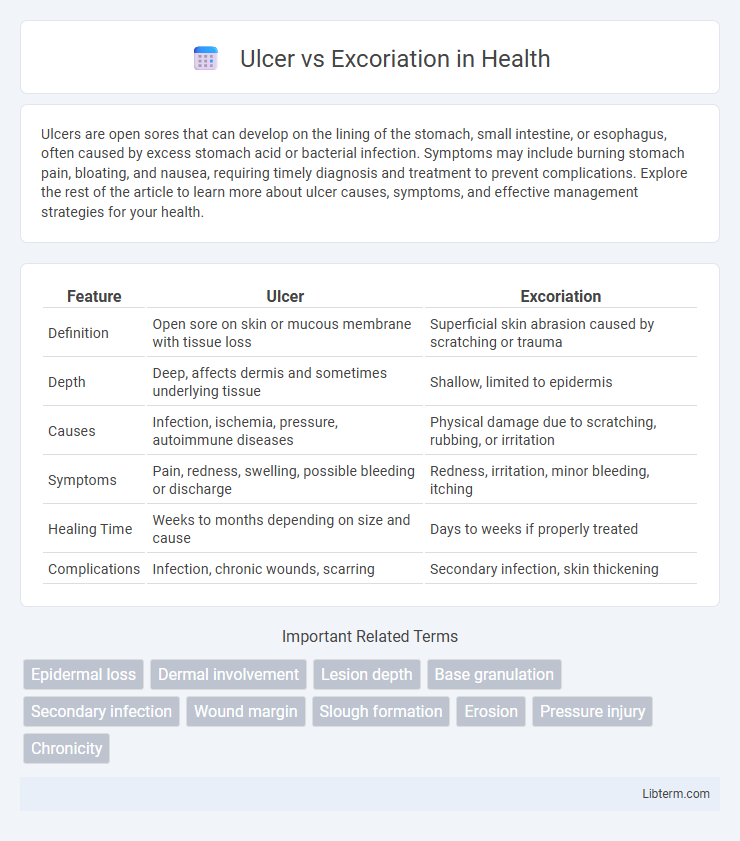Ulcers are open sores that can develop on the lining of the stomach, small intestine, or esophagus, often caused by excess stomach acid or bacterial infection. Symptoms may include burning stomach pain, bloating, and nausea, requiring timely diagnosis and treatment to prevent complications. Explore the rest of the article to learn more about ulcer causes, symptoms, and effective management strategies for your health.
Table of Comparison
| Feature | Ulcer | Excoriation |
|---|---|---|
| Definition | Open sore on skin or mucous membrane with tissue loss | Superficial skin abrasion caused by scratching or trauma |
| Depth | Deep, affects dermis and sometimes underlying tissue | Shallow, limited to epidermis |
| Causes | Infection, ischemia, pressure, autoimmune diseases | Physical damage due to scratching, rubbing, or irritation |
| Symptoms | Pain, redness, swelling, possible bleeding or discharge | Redness, irritation, minor bleeding, itching |
| Healing Time | Weeks to months depending on size and cause | Days to weeks if properly treated |
| Complications | Infection, chronic wounds, scarring | Secondary infection, skin thickening |
Introduction to Ulcer and Excoriation
Ulcers are localized tissue breaks characterized by the loss of the epidermis and part of the dermis, often caused by factors like infection, pressure, or vascular insufficiency. Excoriations are superficial abrasions resulting from mechanical trauma, such as scratching or rubbing, primarily affecting the epidermis without deep tissue loss. Understanding the distinction between ulcers and excoriations is crucial for accurate diagnosis and effective treatment in dermatology and wound care.
Defining Ulcer: Causes and Characteristics
Ulcers are defined as open sores on the skin or mucous membranes resulting from the loss of surface tissue, often extending into the underlying dermis or subcutaneous layers. Common causes include prolonged pressure, vascular insufficiency, infections, and chronic inflammation, which disrupt normal tissue repair processes. Ulcers typically present with distinct edges, a necrotic or granulated base, and can be painful or painless depending on the underlying etiology.
Understanding Excoriation: Causes and Features
Excoriation refers to superficial skin abrasions caused by repeated scratching or rubbing that removes the epidermis, often resulting from conditions like eczema, psoriasis, or insect bites. Unlike ulcers, which are deeper lesions involving loss of skin and underlying tissue, excoriations are typically shallow and present as linear or irregular marks accompanied by redness and sometimes bleeding. Recognizing excoriation's causes, including psychological factors such as stress-induced scratching, is essential for effective treatment and preventing secondary infections.
Key Differences Between Ulcer and Excoriation
Ulcers are deep lesions caused by loss of the epidermis and often extend into the dermis, frequently resulting from prolonged pressure, infection, or vascular insufficiency. Excoriations are superficial skin abrasions caused by scratching, characterized by linear or irregularly shaped marks limited to the epidermis. While ulcers typically heal slowly with potential for scarring, excoriations generally heal rapidly without significant tissue loss.
Common Locations on the Body
Ulcers commonly appear on the lower extremities, especially the legs and feet, due to poor circulation or pressure, while excoriations are frequently found on accessible body areas such as the forearms, hands, and face caused by scratching. Diabetic foot ulcers often manifest on pressure points like the toes and soles, whereas excoriations result from repetitive trauma or skin picking typically on exposed or easy-to-reach areas. Understanding these distinct common locations aids in accurate diagnosis and targeted treatment planning for skin lesions.
Clinical Presentation and Symptoms
Ulcers present as well-defined, deep lesions with a loss of the epidermis and sometimes the dermis, often accompanied by pain, redness, and swelling, frequently seen in conditions such as venous insufficiency or pressure sores. Excoriations are superficial linear or punctate abrasions caused by scratching or trauma, primarily manifesting as redness, mild bleeding, and pruritus without significant tissue loss. Clinical differentiation relies on depth and cause of tissue damage, with ulcers indicating sustained injury and excoriations reflecting acute surface irritation.
Diagnostic Methods for Ulcer and Excoriation
Diagnostic methods for ulcers primarily involve visual inspection, biopsy, and imaging techniques such as endoscopy or dermoscopy to assess tissue depth and characteristics. Excoriations are diagnosed through clinical examination highlighting superficial skin abrasions, often supplemented by patient history to identify causative factors like scratching or trauma. Laboratory tests including skin swabs and cultures may assist in differentiating secondary infections associated with both ulcers and excoriations.
Treatment Options: Ulcer vs Excoriation
Ulcer treatment often involves addressing underlying causes such as infection, ischemia, or pressure, with options including antibiotic therapy, debridement, and advanced wound dressings like hydrocolloids or alginates to promote healing. Excoriation management primarily focuses on preventing further skin trauma and irritation, utilizing topical corticosteroids, antiseptics, and emollients to reduce inflammation and protect the epidermis. Both conditions benefit from meticulous wound care, but ulcers typically require more intensive interventions to restore tissue integrity compared to the superficial nature of excoriations.
Prevention and Patient Care Strategies
Ulcer prevention centers on maintaining skin integrity through regular hygiene, moisture control, and pressure relief, especially in immobile or diabetic patients. Excoriation management involves avoiding repetitive scratching, using emollients, and addressing underlying causes such as allergies or infections to prevent skin barrier disruption. Patient care strategies emphasize early identification, individualized skin assessments, and patient education to optimize healing and reduce recurrence risk.
When to Consult a Healthcare Professional
Ulcers that persist beyond two weeks, exhibit increased pain, bleeding, or signs of infection require prompt medical consultation to prevent complications such as cellulitis or chronic wounds. Excoriations accompanied by severe pain, spreading redness, swelling, or pus formation indicate possible bacterial infection necessitating professional evaluation and treatment. Immediate healthcare attention is essential for non-healing wounds, systemic symptoms like fever, or underlying conditions such as diabetes that impair healing.
Ulcer Infographic

 libterm.com
libterm.com